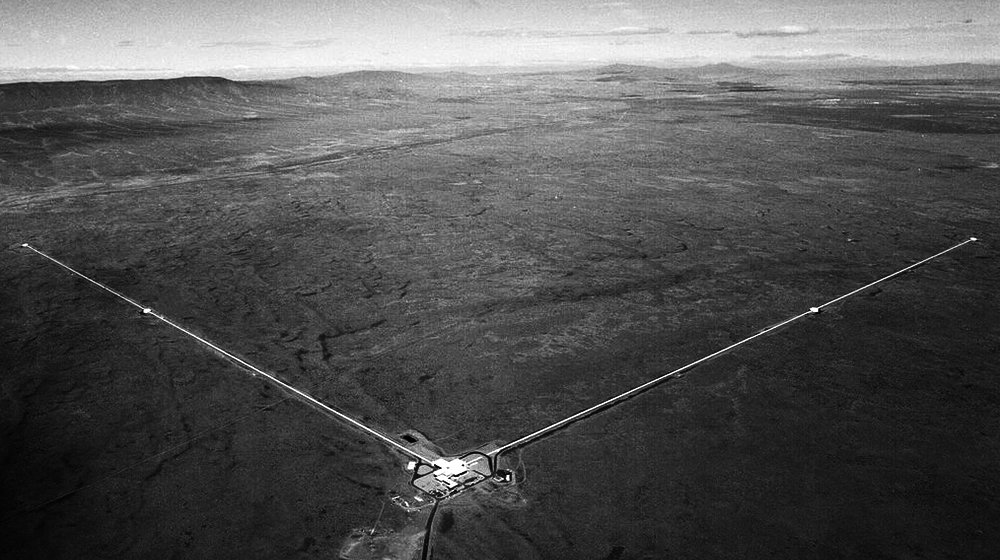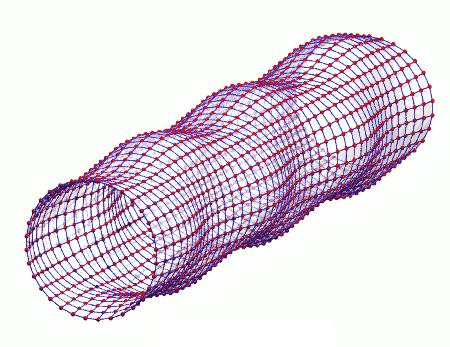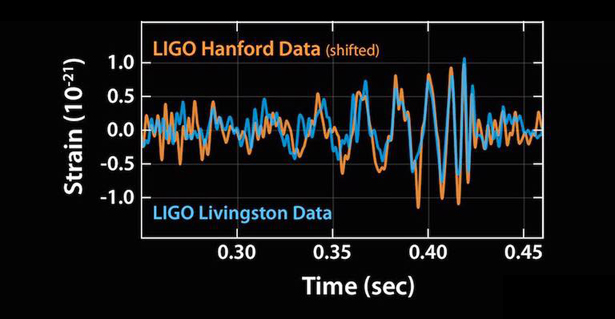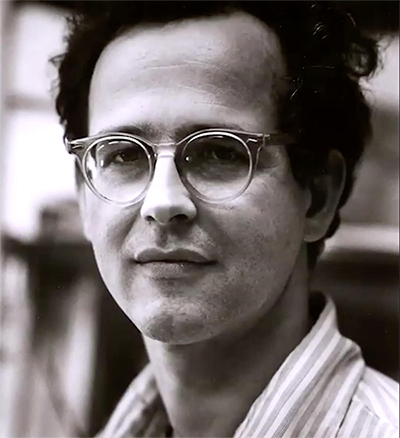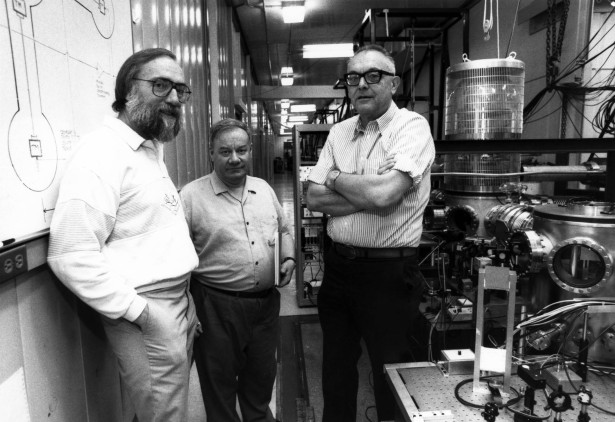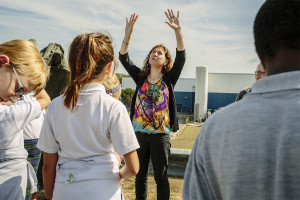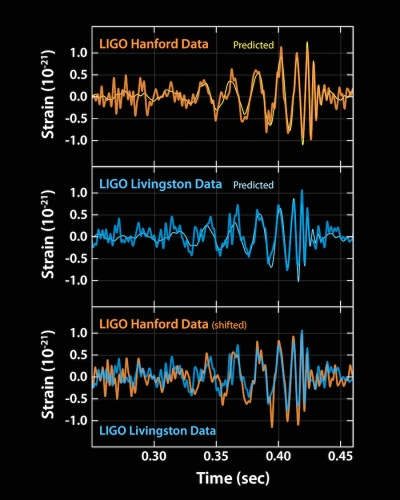Gravitational Waves Discovered from Colliding Black Holes
The LIGO experiment has confirmed Albert Einstein’s prediction of ripples in spacetime and promises to open a new era of astrophysics

Credit: Caltech
About 1.3 billion years ago two black holes swirled closer and closer together until they crashed in a furious bang. Each black hole packed roughly 30 times the mass of our sun into a minute volume, and their head-on impact came as the two were approaching the speed of light. The staggering strength of the merger gave rise to a new black hole and created a gravitational field so strong that it distorted spacetime in waves that spread throughout space with a power about 50 times stronger than that of all the shining stars and galaxies in the observable universe. Such events are, incredibly, thought to be common in space, but this collision was the first of its kind ever detected and its waves the first ever seen. Scientists with the Laser Interferometer Gravitational-Wave Observatory (LIGO) announced on Thursday at a much-anticipated press conference in Washington, D.C. (one of at least five simultaneous events held in the U.S. and Europe) that the more than half-century search for gravitational waves has finally succeeded.
“This was truly a scientific moonshot, and we did it, we landed on the moon,” LIGO executive director David Reitze said during the announcement.
“There are people who’ve put their entire life into this search, and there are people who died before having a chance to see anything,” says LIGO team member Szabolcs Márka, a physicist at Columbia University. “It’s really a wonderful feeling that you have validated the investment of the tremendous amount of work. And it's not just that you found something, but you gave something to everybody, to the rest of the human race.”
Albert Einstein first predicted gravitational waves in 1916 based on his general theory of relativity, but even he waffled about whether or not they truly exist. Scientists began seeking these ripples in spacetime in the 1960s but none succeeded in measuring their effects on Earth until now. LIGO’s discovery, accepted for publication in Physical Review Letters, not only provides the first direct evidence for gravitational waves but also opens the door to using them to study the powerful cosmic events that create them. “It’s a huge deal,” says Luis Lehner, a physicist at the Perimeter Institute for Theoretical Physics in Ontario who is unaffiliated with the LIGO project. “It has pushed the fundamental theory of gravity forward in a very strong way and gives us an incredible tool to probe very deep questions of the universe.”
“ONE OF THE MOST COMPLEX SYSTEMS EVER BUILT”
More than 1,000 scientists work on the $1-billion LIGO experiment, which is funded by the National Science Foundation. The project uses two detectors, one located in Washington State and the other in Louisiana, to sense the distortions in space that occur when a gravitational wave passes through Earth. Each detector is shaped like a giant L, with legs four kilometers long. Laser light bounces back and forth through the legs, reflecting off mirrors, and amazingly precise atomic clocks measure how long it takes to make the journey. Normally, the two legs are exactly the same length, and so the light takes exactly the same amount of time to traverse each. If a gravitational wave passes through, however, the detector and the ground beneath it will expand and contract infinitesimally in one direction, and the two perpendicular legs will no longer be the same size. One of the lasers will arrive a fraction of a second later than the other.

GRAPHIC BY JEN CHRISTIANSEN
LIGO must be unbelievably sensitive to measure this change in the length of the legs, which is smaller than one ten-thousandth the diameter of a proton, or less than the size of a soccer ball compared with the span of the Milky Way. “It's one of the most complex systems ever built by mankind,” Márka says. “There are so many knobs to turn, so many things to align, to achieve that [sensitivity].” In fact, the experiment is so delicate that unrelated events such as an airplane flying overhead, wind buffeting the building or tiny seismic shifts in the ground beneath the detector can disturb the lasers in ways that mimic gravitational signals. “If I clap in the control room, you will see a blip,” says Imre Bartos, another member of the LIGO team at Columbia. The researchers carefully weed out such contaminating signals and also take advantage of the fact that the detectors in Washington and Louisiana are highly unlikely to be affected by the same contamination at the same time. “By comparing the two detectors, we can be even more certain that what we are seeing is something that's coming from outside the Earth.”
LIGO began its first run in 2002, and hunted through 2010 without finding any gravitational waves. The scientists then shut down the experiment and upgraded nearly every aspect of the detectors, including boosting the power of the lasers and replacing the mirrors, for a subsequentrun, called Advanced LIGO, that began officially on September 18, 2015. Yet even before then the experiment was up and running: the signal arrived on September 14 at 5:51 A.M. Eastern time, reaching the detector in Louisiana seven milliseconds before it got to the detector in Washington. Advanced LIGO is already about three times more sensitive than the initial LIGO, and is designed to become about 10 times more sensitive than the first iteration in the next few years.
LONG TIME COMING
Before now, the strongest evidence of gravitational waves came indirectly from observations of superdense, spinning neutron stars called pulsars. In 1974 Joseph Taylor, Jr., and Russell Hulse discovered a pulsar circling a neutron star, and later observations showed that the pulsar’s orbit was shrinking. Scientists concluded that the pulsar must be losing energy in the form of gravitational waves—a discovery that won Taylor and Hulse the 1993 Nobel Prize in Physics. Ever since this clue, astronomers have been hoping to detect the waves themselves. “I've certainly been looking forward to this event for a long time,” Taylor says. “There is a long history, and I think projects that take this long to bear fruit require an awful lot of patience. It's about time.”
The discovery is not just proof of gravitational waves, but the strongest confirmation yet for the existence of black holes. “We think black holes exist out there. We have very strong evidence they do but we don’t have direct evidence,” Lehner says. “Everything is indirect. Given that black holes themselves cannot give any signal other than gravitational waves, this is the most direct way to prove that a black hole exists.”
LIGO’s ability to study the characteristics of gravitational waves will allow scientists to study black holes in a whole new way. Researchers would like to know the details of how two black holes collide, and whether a new black hole arises as theory suggests. “We're talking about two objects that do not emit light—they’re completely dark,” says Janna Levin, a theorist at Barnard College at Columbia University who is outside the LIGO collaboration. “In the details of a collision and in terms of the gravitational waves, you could see the formation of a new black hole.” The observatory should also be able to see gravitational waves created by other cataclysmic events, such as exploding supernovae and collisions of two neutron stars.
LIGO and future gravitational wave experiments will also allow physicists to put general relativity to the test. The 100-year-old theory has stood the test of time but it still conflicts with the theory of quantum mechanics that rules over the subatomic realm. “We know general relativity should show cracks at some point, and the way it shows them will guide our theory to one that is more complete,” Lehner says. “This is pushing the theory over six orders of magnitude compared to the previous strongest test,” which came from observations of pulsars.
LIGO is the first of many observatories that will join this new era of gravitational astronomy. A similar project called Virgo will come online this year in Italy, and later this decade the Kamioka Gravitational Wave Detector (KAGRA) in Japan will begin observations. Ground-based telescope projects called pulsar timing arrays aim to study gravitational waves by noting delays in light from pulsars arriving on Earth after traveling through wave-stretched space. And a spacecraft called Lisa Pathfinder launched last December to test technology for a proposed space-based observatory that will be sensitive to longer-wavelength gravitational waves from supermassive black hole collisions.
“Every time you open a new window to the universe we always discover new things,” Lehner says. “It’s like Galileo pointing the first telescope to the sky. Initially he saw some planets and moons, but then as we got radio, UV and x-ray telescopes, we discovered more and more about the universe. We are pretty much at the moment where Galileo was beginning to see the first objects around Earth. It will have such a huge impact on the field.”
